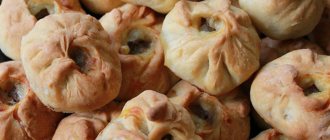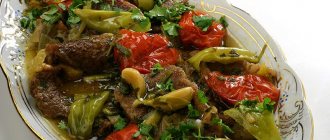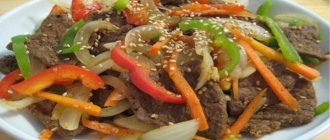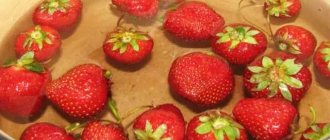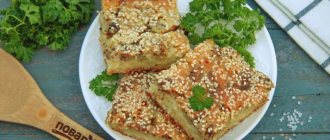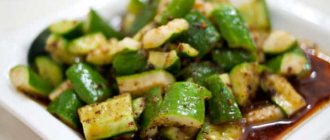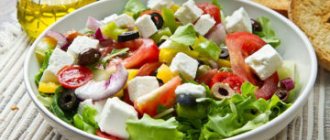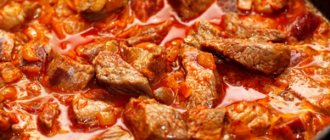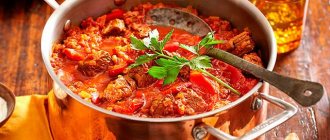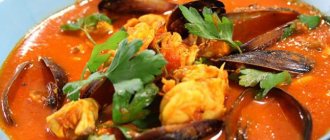Tatar cuisine is the result of a centuries-old history of the development of an entire people, which was influenced not only by the living conditions and cultural and religious characteristics of the Tatar people, but also by the traditions of neighboring peoples: the Mari, Chuvash, Bashkirs and others.
- Main ingredients of Tatar cuisine
- Popular dishes of Tatar cuisine
- Cooking methods
Ash - ritual feast
Translated from Tatar, the word ash means “food” and, in particular, “soup”. This is also what they call the tradition of a ritual feast. Modern Muslim Tatars hold ash in honor of nikah (marriage ceremony), the birth of a child, in memory of relatives, and during sacred holidays. Ash usually takes place within the family circle. Each Muslim family decides for itself when to hold it, but it always begins the same way - with reading the Koran.
An obligatory participant in any asha is an elderly woman, respected in the community (for example, an abystai - the wife of a mullah, a Muslim priest), or a man who can read the Koran in Arabic. Sometimes, on special occasions, it is the mullah himself who can deliver a short sermon. The Koran and hadith (traditions about the words, actions and deeds of Muhammad) are listened to before the meal, but already sitting at a set table. There is silence in the room, interrupted only by reading in Arabic. This is the most important part of the ash, its main meaning.
Tatar woman. 18th century Wikimedia Commons
There is no alcohol on Asha: it is prohibited by Sharia law. All food is halal, that is, this is food allowed for Muslims, but what to serve, each housewife decides independently. Most likely, on the table there will definitely be chak-chak, kosh-tele (literally “bird tongues” - dough brushes fried in oil), various pies made from yeast dough, and dried fruits. Koymak (pancakes) may be present.
The table should be plentiful, it is prepared in advance. By the time the guests are seated, there are already fruits, berries, fresh or pickled vegetables, pastries, and sweets on it. Modern tradition allows for fish and meat snacks, such as smoked fish or kazy, that is, horse sausage.
Until modern times, ash, like any Tatar feast, began with tea. Nowadays, before serving hot dishes, compotes, juices or water are placed on the table.
A hot lunch begins with soup, and most often it is tokmach - noodles in chicken broth. The noodles should be very thin. Now the tradition is fading, but once upon a time it was believed that a good bride must be able to cut noodles “into a web.” Moreover, of the two brides they could choose the one that cut the noodles thinner. The tradition of teaching girls to roll out and cut noodles from early childhood was typical for both Muslims and Kryashens - baptized Tatars.
After the soup, the second dish is brought to the table, which is often a large pie called Gubadiya (Tat. Gөbadiya) or zur-belesh (Tat. Zur Balesh). Zur-belesh is filled with potatoes, meat (goose or beef) and onions. Until the end of the 19th century, when the Tatars did not know potatoes, they put cereals, most often spelt, into zur-belesh. This is a hearty and very elegant pie.
Belesh is eaten with a spoon: since there is much less dough in it than there is a rich filling, the top “lid” is first removed from it, and these pieces of dough are laid out on plates in portions instead of bread. Place the filling next to it. After this, the bottom layer of belesh is distributed, soft and soaked in juice from the filling; many consider it the most delicious part of the pie. Elderly guests, such as abystai, receive the bottom of belesh.
In the final part of the asha, before serving tea, potatoes and meat (beef or chicken, boiled or stewed) can be brought to the tables. Potatoes are a modern innovation, a tribute to the habit of eating meat only with a side dish. Until the 20th century, they simply put meat cut into pieces on the table and distributed it to guests; the fattest parts went to the most respected of those present.
It ends with a tea party. This is where the numerous sweets come into play, which are on the table from the very beginning of the meal.
The meaning of ash is not only to provide nourishing and tasty food to guests, but also to observe religious traditions. Therefore, another obligatory part of the ash is the distribution of sadaqa, gifts in honor of Allah, to each guest: these can be scarves, pieces of fabric, pieces of soap or other small things. Readers of the Koran receive more significant gifts than others.
In addition, each guest takes home a gift from the table (ta. kүchtәnәch). The ash is laid in such a way that after it there is always enough food left to distribute to those leaving. Therefore, you can return from asha with a piece of pie, fruit, chak-chak or kosh-tele - whatever the hostess will wrap with her.
Main course recipes
Azu in Tatar
Required ingredients:
- meat - beef or lamb tenderloin - about 1 kg;
- onion – 3 heads;
- potatoes – 6 pcs.;
- tomatoes – 6 pcs. medium size, or tomato paste – 500 g;
- broth - 1 l;
- garlic – 7 cloves;
- pickled cucumbers – 7 pcs.;
- greens – any, about 150 g;
- melted butter – 100 g;
- seasonings - to taste.
Time spent on cooking: 2-2.5 hours.
Calorie content: 390 kcal per 100 g.
Description of preparation:
- Cut the tenderloin into small pieces, approximately 2*3 cm, about 2 cm thick.
- Heat the oil in a thick-walled saucepan or cauldron, fry the meat until crusty and reduce the heat. Stew.
- Cut the onion into half rings, fry it in melted butter until golden.
- Place onions in a cauldron with meat and pour in tomato paste, or mash peeled tomatoes.
- Pour the resulting mass with broth and cook over low heat for about 40 minutes.
- Cut the cucumbers into small strips, peel them, add to the total mass and simmer for about 10 minutes.
- Cut the potatoes into cubes and fry in a separate frying pan in the same melted butter, but do not bring them to full readiness.
- Transfer the potatoes to the meat and simmer for about half an hour.
- Add finely chopped garlic and herbs to the finished dish.
Kazylyk – Tatar-style dried sausage
Required ingredients:
- meat – 1-2 kg of peritoneal part of beef or horse meat;
- intestines or special film for sausage;
- seasonings to taste.
Time spent on cooking: up to 3 months.
Calorie content: 300-350 kcal per 100 g.
Recipe step by step:
- Twist the meat or cut it into pieces 3 cm wide, 6 cm long, 2 cm thick, add a lot of pepper and salt, leave in the refrigerator for 2 days.
- Treat the intestines - rinse with water, then turn them inside out and get rid of mucus, wash, and tie the other end with coarse thread.
- Fill the intestines, alternating meat with pieces of fat.
- Use a toothpick or fork to make small holes in the intestine so that the fat can drain out.
- Hang the sausage for 2-3 days in the sun.
- For 2-2.5 months, put the kazylyk in a cellar or other dark, cool place.
- The finished sausage is cut into small circles like any other sausage and served as a second course along with fried potatoes.
Tatar tea party
It is believed that tea was brought to the Volga region by the Mongols when they conquered Great Bulgaria in the 13th century, but this drink really took hold in the 17th century, when the Russian Empire established trade ties with China. At the beginning of the 18th century, tea in Russia could only be bought in Moscow, St. Petersburg and Kazan.
In the 19th century in Kazan there were already five large tea houses and 27 shops selling pressed tiles from China. And if in the 17th century tea was very expensive and was drunk only in wealthy families, and ordinary people used it as medicine or on holidays, then by the 19th century tea drinking became firmly established in Tatar life, and the samovar became perhaps the main item in the house. Ethnographer Nikolai Vorobyov wrote that if a family sells or pawns a samovar, this means that it has reached complete poverty and is ready to lose its most precious possession.
Tea drinking in the mullah's house. Ufa province, 1911 Community “Ancient Tatar photographs \ Iske surәtlәr” / “Vkontakte”
The Tatars always drank tea very hot, almost boiling. This tradition continues today. It was also customary to add warmed milk to tea so that the temperature in the cup remained high. Often, in order to save brewing and add flavor to the tea, herbs were brewed along with the tea bar: oregano (Tat. mәtruůshkә, in some dialects yylyut), thyme and St. John's wort. Sugar was not put into tea: it was eaten only as a bite, so as not to spoil the taste of the drink.
The traditional tea table is very plentiful: butter, honey, kabartma (yeast dough crumpets), the already mentioned kosh-tele and chak-chak, nuts, dried fruits, pastilles from apples and berries. According to the rules of hospitality, any person who comes to the house must be fed, but the meal can be limited to an endlessly long tea party with a serving of sweets and pastries.
Tea itself is also included in any traditional meal. Tatar writer Rabit Batulla, in his study of Tatar cuisine “Tatar dәstarkhany”, 2009, gives the following order of dishes in ancient feasts:
Tea Belesh Shulpa (tokmach) Some second course, for example fried chicken Kalzha (large boiled pieces of horse meat, beef) Rice or millet stew Some second course, for example fried fish Karta (boiled horse entrails) Beshbarmak Tea Fried lamb Kullama with salma Fruit Kumis (honey or buza Buza is a low-alcohol drink made from millet, buckwheat, barley, etc.) After a long pause, tea is served again
According to Batulla, this order of serving dishes has been preserved in the Mishar villages of Mishari , a subethnic group of Tatars in the Volga and Urals regions. still.
The people's love for tea is reflected in Tatar proverbs and sayings, for example, “If you drink tea, summer has come to your soul” or “When a woman recognized tea, she forgot about yarn.”
Gubadia
This is a huge pie made of unleavened dough with several layers of fillings, which was traditionally baked for a wedding. There are different types of Gubadiya: the sweet one is served with tea, the meat one is served as a main course. Today gubadia is made with rice, but until the 20th century, the multi-layered sweet filling consisted mainly of berries and dried fruits. However, dried fruits were an indispensable ingredient in meat gubadiya too. Some ethnographers mention that they were considered a talisman capable of protecting newlyweds from bad omens.
An obligatory ingredient in Gubadiya today is kort, specially prepared cottage cheese: it is simmered over a fire for four to seven hours, mixed with sugar and butter. The result is a brown crumbly sweet mass, which is stored for a very long time and has a characteristic taste of baked milk. Several centuries ago, it was customary to take kort on long trips: it is very filling and does not spoil for a long time.
Gubadiya with kort, rice, egg and raisins © Egor Aleev / TASS
The number of layers in wedding gubadiya is not accidental: it symbolized the number of days that a young husband can stay in the house of his wife and her parents after the wedding. The fact is that in many villages the wife did not move to her husband right away: first the husband stayed for several days in her parents’ house, then he came on Thursdays for several weeks, and only after that the wife moved to her husband’s house. Such separate living also had economic significance: the groom’s parents could not always pay the bride price right away. So the wife went to their house only after her family received everything that was due under the prenuptial agreement.
Tatar women in the kitchen. 1860 British Library
Thus, there could be from five to nine layers in Gubadiya. At the wedding, it was ceremoniously cut by someone from the groom's side (usually the father). This was done in one slow motion to reveal all the fillings at once and check how the pie was baked. Baking all the layers evenly in a rustic oven was a challenge. If the inside of the gubadiya remained damp, then right during the wedding they began to bake a new one. After the festive feast, it was divided according to the number of guests and given to them as a gift. If gubadia was obtained the first time, then it was first divided into four parts, one of which was sent to the groom’s house (for those relatives who could not come to the wedding), and the rest was eaten at the wedding feast.
Before cutting the gubadia, the groom's father had to cover it with a towel and put money on it - to perform a kind of ritual of buying back the pie.
Today, Tatars perceive Gubadiya as a delicacy for tea, and its filling consists of a layer of korta and sweet rice with dried fruits. But no wedding is still complete without it. Just like without chak-chak.
Chuck-chuck
Chak-chak - tiny pieces of butter dough, fried in oil and glued together with honey glaze, the most famous Tatar dish.
According to most ethnographers, the Tatars inherited the chak-chak recipe from the Bulgars. To make it, you need only local products: it contains neither dried fruits (which are brought from Central Asia) nor special spices. Only honey, butter, eggs, milk and flour.
In the 19th century, the Tatar ethnographer Kayum Nasyri cited a Bulgarian legend, according to which the khan ordered a new treat to be invented for his son’s wedding. But not simple, but festive, easy to prepare, non-perishable, tasty, satisfying and so that soldiers can eat it on the go. According to legend, a dish that meets all the conditions was invented by the wife of a shepherd.
Girls with chak-chak. Bulgarian Museum-Reserve, 2017 © Egor Aleev / TASS
At the wedding, the khan endowed the chak-chak with all sorts of symbolic meanings: the abundance of dough balls meant the numerous offspring that the newlyweds would have; the pieces glued together symbolized the connection between the spouses; the golden color of the dish is the shine of coins; the speeches of the spouses should have been as sweet as honey, and the shape of the dish - a slide - was a wish that things would only go up for the young people.
Perhaps Nasyri added something of his own, but chak-chak has firmly entered into the wedding tradition - a modern Tatar wedding cannot do without it. Chak-chak also plays the role of a Russian loaf of bread in it: after the wedding ceremony, the newlyweds take the chak-chak out on a towel, and they bite it on both sides. Whoever has the largest piece in his mouth will lead the house.
While gubadia for a wedding in different villages could be prepared both in the bride’s house and in the groom’s house, chak-chak was always made at the bride’s house. It is considered a women's dish. It, like gubadia, was also divided into four parts, and a quarter was sent to the groom’s relatives who were not present at the wedding.
Some experts trace the name chak-chak to the name of a character in the polytheistic pantheon of the ancient Bulgars. It is pronounced Chagy or Chaga, and this character is supposedly responsible for the family hearth and prosperity. But this is unconfirmed information - most ethnographers are still inclined to believe that the name of the dish comes from a similar-sounding Tatar word, which translates as “slightly” (the pieces of dough are very small, chak-chak is assembled from many small “slightly”).
Azu: aromatic beef in a cauldron
You can cook the basics authentically in a cauldron in the fresh air or, more practically, on the stove. To prepare the dish, use any part of the beef pulp. This will not affect the quality of the dish, only the cooking time - tougher parts need longer simmering. As for the spices that distinguish Tatar dishes, the recipe with the basic photo is prepared practically without them. The combination of pickled cucumber and sweet carrots adds an interesting taste to the meat. An obligatory component is a mixture of peppers with a pronounced aroma.
Use:
- 1.5 kg. beef pulp;
- 4 onions;
- 5 pickled cucumbers;
- 4 carrots;
- 30-50 gr. tomato paste;
- 1 tbsp. l. dried dill;
- Pepper mixture;
- Sunflower oil.
Azu: aromatic beef in a cauldron
How to cook:
- Wash the meat, cut into small pieces.
- Peel and wash the carrots.
- Peel the onion, but do not cut off the root.
- Wash the onion and chop into rings.
- Cut the carrots into strips - a typical cut in Tatar dishes, recipes for which are prepared in a cauldron. Or chop into large half rings, as in the photo
- Grate the cucumbers on a coarse grater.
- Place the cauldron on the fire, pour in sunflower oil. The peculiarity of Tatar cuisine is the abundant use of fat. Therefore, pour more oil than usual.
- Bring the oil to a hot state, add the carrots. Fry until done, remove to a plate.
- Place onion rings into a cauldron and fry until golden brown.
- Take the onion to the carrots.
- Place meat in a cauldron, fry, and bring the Tatar cuisine dish to readiness. Recipes with photos cooked in a cauldron over an open fire acquire a special aroma.
- Add dill, tomato paste, stir.
- Add cucumber, fried onions and carrots, stir.
- Simmer all ingredients together for 10 minutes, turn off.
- Add the ground pepper mixture after turning off, stir again.
Kazy and other horse meat dishes
Horse meat (Tat. Khylky) was very important in traditional Tatar cuisine. Islam prohibits eating pork, so the main types of meat for Muslim Tatars are lamb, beef and horse meat. Unlike pork, lamb and beef, eating horse meat is not clearly regulated in Islam, so different Muslim nations solve this issue in different ways. Horse meat is eaten not only by Tatars, but also by Kazakhs, Kyrgyz, Bashkirs, Uzbeks and many other peoples who were originally nomadic and lived in the steppe. The horse gave them everything - food, clothing, harness, and a house (yurts were covered with horse skins) - it was the source of life in every sense. But Arabs and Turks do not eat horse meat: for them, a horse is, first of all, a comrade in battle, and eating it is shameful.
Kazy © Sara Yeomans / CC BY 2.0
The people of the steppe, including the Tatars, always clearly separated horses for racing, for war, for work and for food. Of course, they did not eat racers or draft horses. Special horses were raised for the table (they were called Hylky). As a rule, a young mare from two to four years old was used for food. An analogue of salted lard was made from the layer of fat under the mane; the meat was used for stewing, frying, it was dried, and it was used to make stew. The entrails were also prepared in a special way and eaten.
Tatars. English engraving. Around 1880 Getty Images
There is little horse meat on the modern Tatar table: after all, beef and poultry are more accessible and widespread in the Volga region. But the Tatars continue to cook beshbarmak from it, stew meat and make the famous kazy - horse sausage. Many people call it kazylyk, but this is not entirely correct: kazylyk is only a filling for making sausage.
Traditional recipes involve the use of peritoneum meat with the addition of fillet pieces. The meat should be very fatty - about 30-40%. Real kazy takes a long time to prepare: it is dried for about three months. Just a century ago, kazy ate regularly, at least in wealthy homes; today it is more of a delicacy.
Main ingredients of Tatar cuisine
Since the Tatars were originally a nomadic people, the basis of their national cuisine is meat - lamb, horse meat, beef, chicken, duck, game. According to Islamic traditions, Tatar cuisine recipes do not use pork, which is considered dirty meat. The remaining types of meat are prepared in different variations: they are used to cook soups and broths, and are used in preparing main courses and filling pies.
The second most common ingredient in Tatar cuisine is various cereals. Tatars love porridges: rice, peas, millet, buckwheat. They cook them with the addition of vegetables or dried fruits.
Tatar cuisine is rich in a variety of baked goods, so the third most important ingredient is dough, mainly yeast, from which fluffy, soft pastries are obtained. Tatar housewives bake both small pies and large closed and open pies with various sweet and savory fillings. The main flour product, like among many peoples of Eurasia, is bread - among the Tatars it is called ikmek.
Another important ingredient of Tatar cuisine is dairy products. Milk in its pure form is practically not used - it is turned into sour cream, kefir or cottage cheese. Katyk is prepared from cow or horse milk by fermentation. The resulting fermented milk product is used to prepare the popular refreshing drink ayran. Katyk is also the base for the Tatar curd product syuzme, from which the Tatar cheese called kort is prepared by long evaporation.

